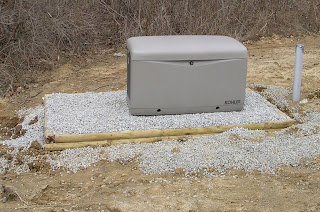Supports and boxes for the lights, and supports for the outlet ready to be covered.
Then we put up the last two big boards. Now all that was left were the pieces for over the door, and the windows.
Just a few pieces left.
We looked over the various pieces that had been cut from the panels we had already used. We found pieces we could cut from for all the remaining locations, and we started cutting. The piece for over the front door was simple. However, the rest of them required transferring the curves from the window tops, onto the Hardie panels, and cutting the curves. That was done, by stapling large pieces of paper above the windows, and then cutting the edges to fit the space that was available. Then we traced the outline onto the Hardie panel, and cut carefully. Dad was quite skilled at using the circular saw to make a rough cut, and then smooth it up to get the fit we wanted.
This process creates a lot of dust. So we wear masks when we work with these panels. Thankfully we are just about done having to cut them. But it was a cold and dusty afternoon.
Panel to go over the guest bedroom window with the rough curve cut in it.
Temperatures outside got up to a little over freezing, but with the propane heater running inside, we had it over 60. It was quite comfortable inside. I got all the edges coated with primer, and they will be ready put up next weekend.
We also checked on a couple things while we were out there. One item was the generator. I had found after I had the generator, that the warranty was reduced from 5 years to 18 months if you don't have a reliable public utility providing your main power. If you don't have an authorized service rep do the "startup" then your warranty starts from the date of manufacture, not the date when you first put it into service, and so would be further shortened. I had read the manuals that came with the generator, and had been in touch with an "authorized service rep". The price for "starting the generator" was quite a shock (around 20% of the cost I had paid for the generator). When I initially had talked to them, I had presumed that the final connections for the gas and electric would be included in that "startup". But when I asked them how the gas piping and electrical wire should be terminated for them to do the "startup" they informed me that the gas and electrical connections had to be finished before they got there. The "startup" service call, was only a little more than them running through a checklist included with the generator and verifying that things had been done correctly. They would run some tests included in that checklist, which can't be performed by an end user without the correct equipment/software, to make sure it shutdown automatically if there was a problem. So I needed to look to see what was going to be involved in making these connections and having it ready for them to "look at". I found there will be a fair amount of time spent to get the panels inside unbolted and out of the way so that I can get to where the connections need to be made. I also found that the generator is currently configured to run on natural gas and that I will have to go through the process to switch it over to run on propane. I am finding myself wishing that I had bought a less expensive generator, since this is going to cost me more in time/dollars than I thought it would. I am thinking that buying the extra few months on my warranty is not worth what the service rep wants to charge.
On Sunday afternoon, Matt went out with me, and helped me start installing the Trex trim work. We started with the base pieces on the garage side. These pieces are along the bottom of the Hardie panel. It took longer than I had hoped, but I figured out some things as we went along. The work was slowed by the fact that I had to custom fit two sides to the rock walls, and I had to lay out the plan for the pieces before we could get started. I also need to use a different saw for making the straight cuts. The circular saw can be used, but to make a very straight and clean cut, I had to work slowly. We have used dad's power miter saw for cutting pieces at his place, and it works fast and makes very nice cuts. I think we will be hauling it out to cut the ends of the rest of the trim boards.






